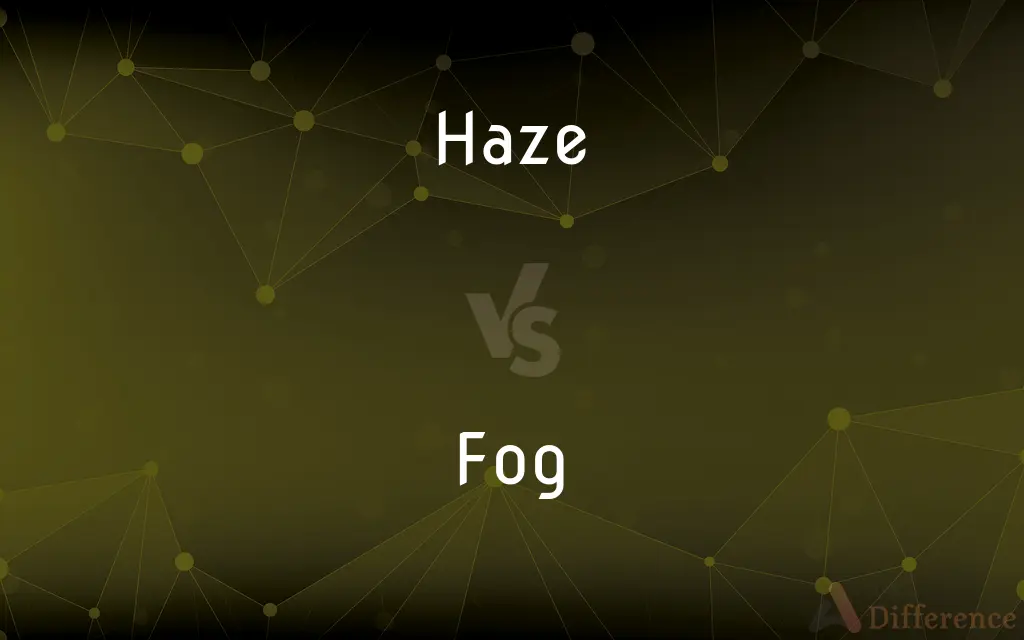Haze vs. Fog — What's the Difference?
By Tayyaba Rehman & Urooj Arif — Updated on February 23, 2024
Haze reduces visibility by scattering light, often dry, while fog is a thick cloud at the ground, moist and denser.

Difference Between Haze and Fog
Table of Contents
ADVERTISEMENT
Key Differences
Haze and fog are atmospheric phenomena affecting visibility, but their causes and characteristics differ. Haze, often associated with dry conditions, results from airborne particles scattering light, leading to reduced clarity over long distances. In contrast, fog is essentially a low-lying cloud, formed when water vapor condenses into tiny droplets suspended in the air, significantly reducing visibility to less than 1 kilometer.
The composition of haze and fog highlights their differences. Haze is made up of fine dust, smoke, and other dry particles, which can originate from various sources such as pollution, forest fires, or dust storms. Fog, however, consists of water droplets that form when the air near the ground cools to the point where it can no longer hold all its moisture.
Visibility in both phenomena is a key differentiator. While haze can reduce visibility across vast areas, often seen as a slight discoloration in the air, fog presents a more immediate and dense barrier to visibility, sometimes reducing it to a few meters. This difference significantly affects transportation and daily activities, with fog posing a higher risk to drivers and aviators.
The conditions leading to the formation of haze and fog are distinct. Haze can occur under a variety of weather conditions, often exacerbated by pollution in urban areas. Fog typically forms in specific conditions near water bodies, in valleys, or other areas where temperature differences cause air to cool rapidly. This distinction is crucial for weather forecasting and environmental monitoring.
The impact on health and environment also varies between haze and fog. Haze, especially when it includes pollutants, can have adverse health effects, irritating respiratory systems and exacerbating conditions such as asthma. Fog, while less directly harmful, can still pose risks through reduced visibility and its potential to carry pollutants close to the ground.
ADVERTISEMENT
Comparison Chart
Composition
Fine dust, smoke, and dry particles
Water droplets
Visibility
Reduces clarity over long distances
Reduces visibility to less than 1 km
Formation
Caused by airborne particles, often pollution-related
Forms when air cools and water vapor condenses
Weather Conditions
Can occur under various conditions, often dry
Requires specific conditions, often near water bodies
Health Impact
Can irritate respiratory systems, worse with pollutants
Reduced visibility poses safety risks, can carry pollutants
Compare with Definitions
Haze
Haze obscures the clarity of the sky due to particles in the air.
The skyline was blurred by the summer haze.
Fog
Reduces visibility significantly, often to under 1 kilometer.
Dense fog made driving on the highway dangerous.
Haze
Atmospheric moisture or dust or smoke that causes reduced visibility
Fog
Composed of tiny water droplets.
The fog droplets settled on the spider's web, making it glisten.
Haze
A slight obscuration of the lower atmosphere, typically caused by fine suspended particles
The cold air has no pollution and very little haze
There was a thick haze on this October morning
Fog
A thick cloud of tiny water droplets suspended in the atmosphere at or near the earth's surface which obscures or restricts visibility (to a greater extent than mist; strictly, reducing visibility to below 1 km)
The collision occurred in thick fog
Haze
Confusion characterized by lack of clarity
Fog
Affects immediate surroundings and visibility.
The fog was so thick, the other side of the street was obscured.
Haze
Often associated with pollution or dust.
A thick haze from the wildfire smoke enveloped the city.
Fog
(intransitive) To become obscured in condensation or water.
The mirror fogged every time he showered.
Haze
Can occur without moisture.
Desert areas frequently experience dry haze.
Fog
Droplets of water vapor suspended in the air near the ground
Haze
Atmospheric moisture, dust, smoke, and vapor that diminishes visibility.
Fog
Fog is a visible aerosol consisting of tiny water droplets or ice crystals suspended in the air at or near the Earth's surface. Fog can be considered a type of low-lying cloud usually resembling stratus, and is heavily influenced by nearby bodies of water, topography, and wind conditions.
Haze
To be hazy, or thick with haze.
Fog
(transitive) To obscure in condensation or water.
Haze
Become hazy, dull, or cloudy
Fog
To envelop, as with fog; to befog; to overcast; to darken; to obscure.
Haze
Not as dense as fog.
Despite the haze, distant objects were still discernible.
Fog
Make less visible or unclear;
The stars are obscured by the clouds
Haze
Haze is traditionally an atmospheric phenomenon in which dust, smoke, and other dry particulates obscure the clarity of the sky. The World Meteorological Organization manual of codes includes a classification of horizontal obscuration into categories of fog, ice fog, steam fog, mist, haze, smoke, volcanic ash, dust, sand, and snow.
Fog
An obscuring haze, as of atmospheric dust or smoke.
Haze
Obscure with a haze
A clump of islands, very green, but hazed in cloud and mist
Fog
An atmosphere in which visibility is reduced because of a cloud of some substance
Haze
To become misty or hazy; blur.
Fog
Can form over water or land when conditions are right.
Fog often rolls in from the sea onto the coast.
Haze
Very fine solid particles (smoke, dust) or liquid droplets (moisture) suspended in the air, slightly limiting visibility. fog, mist.}}
Fog
To cover or envelop with fog.
Haze
An analogous dullness on a surface that is ideally highly reflective or transparent.
The soap left a persistent haze on the drinking glasses.
The furniture has a haze, possibly from some kind of wax.
Fog
To cause to be obscured; cloud.
Haze
(figuratively) Any state suggestive of haze in the atmosphere, such as mental confusion or vagueness of memory.
Fog
To be covered with fog.
Haze
To be or become hazy, or thick with haze.
Fog
(uncountable) A thick cloud that forms near the ground; the obscurity of such a cloud. mist, haze.}}
A bank of fog
Haze
Light vapor or smoke in the air which more or less impedes vision, with little or no dampness; a lack of transparency in the air; hence, figuratively, obscurity; dimness.
O'er the skyThe silvery haze of summer drawn.
Above the world's uncertain haze.
Fog
(intransitive) To become covered with or as if with fog.
Haze
The degree of cloudiness or turbidity in a clear glass or plastic, measured in percent.
Fog
(transitive) To cover with or as if with fog.
Haze
Affects long-distance visibility.
Haze made the mountains look like shadows.
Fog
Watery vapor condensed in the lower part of the atmosphere and disturbing its transparency. It differs from cloud only in being near the ground, and from mist in not approaching so nearly to fine rain. See Cloud.
Fog
Fog is a thick, low-lying cloud at the ground.
The morning fog covered the fields like a blanket.
Common Curiosities
Is fog considered a cloud?
Yes, fog is considered a type of cloud that forms close to the ground.
How does fog form?
Fog forms when air cools to the point where it can no longer hold its moisture, leading to condensation.
Does fog only occur in the morning?
No, fog can occur at any time of day, though it is more common in the morning and evening.
Are haze and fog weather conditions?
Yes, both are atmospheric conditions affecting visibility, but they have different causes and characteristics.
Do haze and fog occur under the same weather conditions?
No, they form under different conditions; haze can occur in dry weather, while fog needs specific temperature and moisture conditions.
Can haze affect health?
Yes, haze, especially when polluted, can irritate the respiratory system and worsen certain health conditions.
Is visibility in haze better than in fog?
Generally, yes, visibility in haze is better than in fog due to its lower density.
Is driving in fog dangerous?
Yes, driving in fog is dangerous due to significantly reduced visibility, requiring caution and slower speeds.
What causes haze?
Haze is caused by fine particles in the air scattering light, often from pollution, dust, or smoke.
Can fog carry pollutants?
Yes, fog can carry pollutants close to the ground, potentially impacting air quality.
Does haze affect all regions equally?
No, haze can be more severe in areas with high pollution levels or specific geographic conditions.
Can technology predict fog?
Yes, meteorological technology can forecast fog by analyzing temperature, humidity, and other atmospheric conditions.
How do people typically protect themselves from fog and haze?
People use fog lights for driving, wear masks for haze, and stay informed through weather forecasts to minimize exposure and risks.
How can one reduce the impact of haze?
Reducing pollution sources and wearing protective masks can help mitigate the health impact of haze.
Can both haze and fog affect flights?
Yes, both can impact aviation by reducing visibility, though fog is usually a more significant concern.
Share Your Discovery

Previous Comparison
Agree vs. Acknowledge
Next Comparison
Cheque vs. CashAuthor Spotlight
Written by
Tayyaba RehmanTayyaba Rehman is a distinguished writer, currently serving as a primary contributor to askdifference.com. As a researcher in semantics and etymology, Tayyaba's passion for the complexity of languages and their distinctions has found a perfect home on the platform. Tayyaba delves into the intricacies of language, distinguishing between commonly confused words and phrases, thereby providing clarity for readers worldwide.
Co-written by
Urooj ArifUrooj is a skilled content writer at Ask Difference, known for her exceptional ability to simplify complex topics into engaging and informative content. With a passion for research and a flair for clear, concise writing, she consistently delivers articles that resonate with our diverse audience.














































